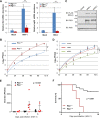Species-Specific Deamidation of RIG-I Reveals Collaborative Action between Viral and Cellular Deamidases in HSV-1 Lytic Replication
- PMID: 33785613
- PMCID: PMC8092204
- DOI: 10.1128/mBio.00115-21
Species-Specific Deamidation of RIG-I Reveals Collaborative Action between Viral and Cellular Deamidases in HSV-1 Lytic Replication
Abstract
Retinoic acid-inducible gene I (RIG-I) is a sensor that recognizes cytosolic double-stranded RNA derived from microbes to induce host immune response. Viruses, such as herpesviruses, deploy diverse mechanisms to derail RIG-I-dependent innate immune defense. In this study, we discovered that mouse RIG-I is intrinsically resistant to deamidation and evasion by herpes simplex virus 1 (HSV-1). Comparative studies involving human and mouse RIG-I indicate that N495 of human RIG-I dictates species-specific deamidation by HSV-1 UL37. Remarkably, deamidation of the other site, N549, hinges on that of N495, and it is catalyzed by cellular phosphoribosylpyrophosphate amidotransferase (PPAT). Specifically, deamidation of N495 enables RIG-I to interact with PPAT, leading to subsequent deamidation of N549. Collaboration between UL37 and PPAT is required for HSV-1 to evade RIG-I-mediated antiviral immune response. This work identifies an immune regulatory role of PPAT in innate host defense and establishes a sequential deamidation event catalyzed by distinct deamidases in immune evasion.IMPORTANCE Herpesviruses are ubiquitous pathogens in human and establish lifelong persistence despite host immunity. The ability to evade host immune response is pivotal for viral persistence and pathogenesis. In this study, we investigated the evasion, mediated by deamidation, of species-specific RIG-I by herpes simplex virus 1 (HSV-1). Our findings uncovered a collaborative and sequential action between viral deamidase UL37 and a cellular glutamine amidotransferase, phosphoribosylpyrophosphate amidotransferase (PPAT), to inactivate RIG-I and mute antiviral gene expression. PPAT catalyzes the rate-limiting step of the de novo purine synthesis pathway. This work describes a new function of cellular metabolic enzymes in host defense and viral immune evasion.
Keywords: HSV-1 UL37; RIG-I; deamidation; glutamine amidotransferase; herpesvirus; immune evasion; innate immune defense; phosphoribosyl pyrophosphate amidotransferase.
Copyright © 2021 Huang et al.
Figures






Similar articles
-
The US3 Kinase of Herpes Simplex Virus Phosphorylates the RNA Sensor RIG-I To Suppress Innate Immunity.J Virol. 2022 Feb 23;96(4):e0151021. doi: 10.1128/JVI.01510-21. Epub 2021 Dec 22. J Virol. 2022. PMID: 34935440 Free PMC article.
-
A Viral Deamidase Targets the Helicase Domain of RIG-I to Block RNA-Induced Activation.Cell Host Microbe. 2016 Dec 14;20(6):770-784. doi: 10.1016/j.chom.2016.10.011. Epub 2016 Nov 17. Cell Host Microbe. 2016. PMID: 27866900 Free PMC article.
-
Species-Specific Deamidation of cGAS by Herpes Simplex Virus UL37 Protein Facilitates Viral Replication.Cell Host Microbe. 2018 Aug 8;24(2):234-248.e5. doi: 10.1016/j.chom.2018.07.004. Cell Host Microbe. 2018. PMID: 30092200 Free PMC article.
-
The Race between Host Antiviral Innate Immunity and the Immune Evasion Strategies of Herpes Simplex Virus 1.Microbiol Mol Biol Rev. 2020 Sep 30;84(4):e00099-20. doi: 10.1128/MMBR.00099-20. Print 2020 Nov 18. Microbiol Mol Biol Rev. 2020. PMID: 32998978 Free PMC article. Review.
-
The emerging roles of glutamine amidotransferases in metabolism and immune defense.Nucleosides Nucleotides Nucleic Acids. 2024;43(8):783-797. doi: 10.1080/15257770.2024.2351135. Epub 2024 May 14. Nucleosides Nucleotides Nucleic Acids. 2024. PMID: 38743960 Free PMC article. Review.
Cited by
-
Inactivation of the UL37 Deamidase Enhances Virus Replication and Spread of the HSV-1(VC2) Oncolytic Vaccine Strain and Secretion of GM-CSF.Viruses. 2023 Jan 27;15(2):367. doi: 10.3390/v15020367. Viruses. 2023. PMID: 36851581 Free PMC article.
-
The US3 Kinase of Herpes Simplex Virus Phosphorylates the RNA Sensor RIG-I To Suppress Innate Immunity.J Virol. 2022 Feb 23;96(4):e0151021. doi: 10.1128/JVI.01510-21. Epub 2021 Dec 22. J Virol. 2022. PMID: 34935440 Free PMC article.
-
A new strategy for treating colorectal cancer: Regulating the influence of intestinal flora and oncolytic virus on interferon.Mol Ther Oncolytics. 2023 Aug 24;30:254-274. doi: 10.1016/j.omto.2023.08.010. eCollection 2023 Sep 21. Mol Ther Oncolytics. 2023. PMID: 37701850 Free PMC article. Review.
-
Co-option of mitochondrial nucleic acid sensing pathways by HSV-1 UL12.5 for reactivation from latent Infection.bioRxiv [Preprint]. 2024 Jul 9:2024.07.06.601241. doi: 10.1101/2024.07.06.601241. bioRxiv. 2024. Update in: Proc Natl Acad Sci U S A. 2025 Jan 28;122(4):e2413965122. doi: 10.1073/pnas.2413965122. PMID: 39005440 Free PMC article. Updated. Preprint.
-
Metabolic Enzymes in Viral Infection and Host Innate Immunity.Viruses. 2023 Dec 24;16(1):35. doi: 10.3390/v16010035. Viruses. 2023. PMID: 38257735 Free PMC article. Review.
References
-
- Schlee M, Roth A, Hornung V, Hagmann CA, Wimmenauer V, Barchet W, Coch C, Janke M, Mihailovic A, Wardle G, Juranek S, Kato H, Kawai T, Poeck H, Fitzgerald KA, Takeuchi O, Akira S, Tuschl T, Latz E, Ludwig J, Hartmann G. 2009. Recognition of 5′ triphosphate by RIG-I helicase requires short blunt double-stranded RNA as contained in panhandle of negative-strand virus. Immunity 31:25–34. doi:10.1016/j.immuni.2009.05.008. - DOI - PMC - PubMed
-
- Goubau D, Schlee M, Deddouche S, Pruijssers AJ, Zillinger T, Goldeck M, Schuberth C, Van der Veen AG, Fujimura T, Rehwinkel J, Iskarpatyoti JA, Barchet W, Ludwig J, Dermody TS, Hartmann G, Reis e Sousa C. 2014. Antiviral immunity via RIG-I-mediated recognition of RNA bearing 5′-diphosphates. Nature 514:372–375. doi:10.1038/nature13590. - DOI - PMC - PubMed
Publication types
MeSH terms
Substances
Grants and funding
LinkOut - more resources
Full Text Sources
Other Literature Sources
Medical
Molecular Biology Databases
